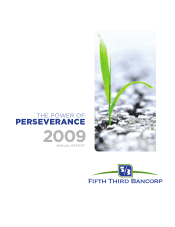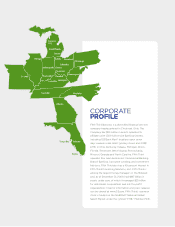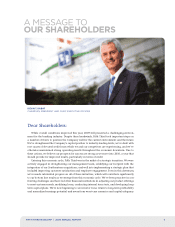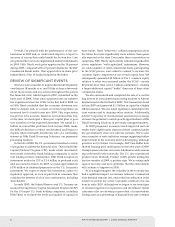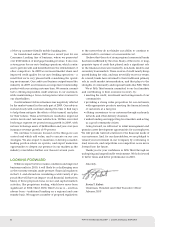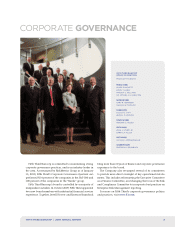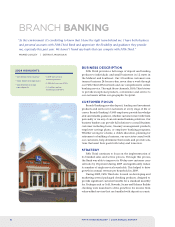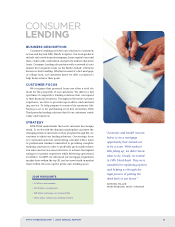Fifth Third Bank 2009 Annual Report Download - page 6
Download and view the complete annual report
Please find page 6 of the 2009 Fifth Third Bank annual report below. You can navigate through the pages in the report by either clicking on the pages listed below, or by using the keyword search tool below to find specific information within the annual report.
to climb as Americans reduce their household debts and
remain reluctant to take on additional leverage. Although
this deleveraging will slow the pace of recovery, consumer
debt burdens have proven unsustainable and this process
will help provide a more stable foundation for future eco-
nomic prosperity.
Even though demand was lower in 2009, we continued
to lend prudently and extended over $75 billion of credit.
We had a record year for mortgage originations in 2009
and financed $23 billion of mortgages. These strong results
reflect the currently low interest rate environment, strong
sales performance, and the disappearance of many non-bank
competitors from the market. I’m pleased with our results,
particularly because we’ve significantly enhanced our credit
risk management over the past several years. We eliminated
all brokered home equity production in 2007, and suspended
residential development and non-owner occupied Commercial
Real Estate lending in early 2008 until excess inventories are
reduced. Additionally, we’ve implemented strict geographic
and industry concentration limits over the past several years
to ensure our exposures to each market are appropriate given
economic conditions.
While prevention of future problems is important, we also
recognize that working through existing troubled situations
is critical to our long-term performance. Fifth Third has in-
vested significantly in loss mitigation, and nearly 5 percent of
our workforce is currently dedicated to working out problem
loans. We now have more than 250 professionals working
with commercial borrowers across our footprint on a wide
variety of issues. We’ve also established dedicated teams who
conduct weekly reviews of particular portfolios – including
auto manufacturing and dealerships, residential construc-
tion, and non-owner occupied commercial real estate. These
actions enhanced our performance in 2009, as well as our
lending infrastructure for the future.
Within our consumer lending business, we have nearly 600
people helping customers work through loan payment issues.
Since inception, we’ve restructured more than $2.7 billion of
consumer loans. I’m proud that we started this program in
early 2007, well ahead of the initiation of the government’s
mortgage modification programs. We’ve deployed people door-
to-door, hosted town hall meetings, and made Fifth Third’s
“eBus” available throughout our footprint to educate people
about their options to restructure loans. Overall, we’ve found
that establishing constructive relationships early on has been
the best way to optimize outcomes for distressed customers
and Fifth Third. This initiative has been very successful, and
our re-default rates have generally been better than industry
averages. We’re making strong partnerships with customers
during this difficult time, and every customer we help stay
in his or her home today provides a strong foundation for a
lifelong relationship with Fifth Third.
2009 ResulTS
Turning to financial results in 2009, we reported net
income of $737 million or $511 million of net income to
common shareholders after preferred dividends. These results
included a $1.1 billion after-tax gain on our processing trans-
action and $206 million in net benefit to earnings related to
our interest in Visa, Inc.
While below 2008 levels, net loan losses remained el-
evated at $2.6 billion. Additionally, we increased the loan
loss reserve by providing nearly $1 billion in excess of net
loan losses during 2009. At year-end, our loan loss reserves
were among the strongest coverage levels in the industry, at
4.88 percent of loans and 116 percent of nonperforming as-
sets. We currently expect net loan losses to decline in 2010.
We don’t expect significant further reserve building to be
necessary given our reserve position and expectation for an
improvement in credit losses in 2010.
Our capital position also is strong on both an absolute
basis and relative to our peers. We’ve been proactive in
managing our capital position throughout this cycle, as evi-
denced by our Tier 1 capital ratio of 13.3 percent at year-end
compared with 10.6 percent at the end of 2008. Our Tangible
Common Equity (TCE) ratio of 6.5 percent also increased
significantly from 2008 and compares very favorably with
our peers.
While credit and capital have been focus areas for the
industry during the past year, we continue to have positive
momentum in a number of our businesses. In 2009 we
generated $553 million of mortgage banking revenue, an
increase of $354 million, or 178 percent compared with
2008. Net interest margin expanded significantly, rising
every quarter since 1Q 2009. We also had an exceptional
4FIFTH THIRD BANCORP | 2009 ANNUAL REPORT

